Hydrogen Safety Prediction and Analysis of Hydrogen Refueling Station Leakage Accidents and Process Using Multi-Relevance Machine Learning
Abstract
1. Introduction
2. Hydrogen Safety Algorithm
2.1. Hydrogen Safety Algorithm
2.2. High-Pressure Hydrogen for Fuel Cell Vehicles
2.3. Operating Restrictions When Refueling Hydrogen Tanks
3. Analysis and Results
3.1. Hydrogen Data Analysis
3.2. Hydrogenation Process of Hydrogen Station
3.3. Results
4. Discussion
Author Contributions
Funding
Conflicts of Interest
References
- Intergovernmental Panel on Climate Change (IPCC). Climate Change 2014: Synthesis Report. Contribution of Working Groups I, II and III to the Fifth Assessment Report of the Intergovernmental Panel on Climate Change; Pachauri, R.K., Meyer, L.A., Eds.; IPCC: Geneva, Switzerland, 2014. [Google Scholar]
- Takahashi, Y. Fieldwork of Casa Rural de Espana: Energy Self-Sufficient Rural Cottage in Spain; International Workshop on Environment & Engineering: Hong Kong, China, 21–22 September 2014. [Google Scholar]
- Takahashi, Y.; Bahcevandziev, K.; Moreira, P.M. Fieldwork of Agriculture Science in North Portugal. In Proceedings of the JSME Conference on Robotics and Mechatronics, Kyoto, Japan, 17–19 May 2015. [Google Scholar]
- Jokela, T.; Cattiau, V.; Tavares, P.; Chevallier, L.; Bouscayrol, A.; Pereirinha, P.; Silva, L.; Trovao, J. Carbon Care Action of IEEE-VPPC’14. In Proceedings of the 2015 IEEE Vehicle Power and Propulsion Conference (VPPC), Montreal, QC, Canada, 19–22 October 2015; Volume 6, pp. 1–6. [Google Scholar]
- Skiba, R. Competency Standards for Emerging Hydrogen Related Activities. Open J. Saf. Sci. Technol. 2020, 10, 42–52. [Google Scholar] [CrossRef]
- Wu, W.; Jing, X.; Du, W.; Chen, G. Learning dynamics of gradient descent optimization in deep neural networks. Sci. China Inf. Sci. 2021, 64, 17–31. [Google Scholar] [CrossRef]
- Xie, T.; Zhang, C.; Xu, Y. Collaborative parameter updating method based on historical gradient mean variance reduction. J. Electron. Inf. Technol. 2021, 43, 956–964. [Google Scholar]
- Su, T.-S.; Lin, P.-R.; Shu, Y.-L.; Tseng, J.-M.; Kao, C.-S. Analysis of the Multi-Relationships and Their Structures for Safety Culture. Open J. Saf. Sci. Technol. 2012, 2, 89–97. [Google Scholar] [CrossRef][Green Version]
- Shi, Z. Cognitive Machine Learning. Int. J. Intell. Sci. 2019, 9, 111–121. [Google Scholar] [CrossRef]
- Dou, Y.; Chen, S. Research on requirement description in program mining. Comput. Eng. Appl. 2006, 10, 46–49. [Google Scholar]
- Rei, M.-H.; Kao, Y.-L.; Yeh, G.-T.; Chen, S.-C. The Influence of the Hydrogen Supply Modes on a Hydrogen Refueling Station. Mod. Econ. 2020, 11, 867–880. [Google Scholar] [CrossRef][Green Version]
- Powars, C.; Unnasch, S.; Kassoy, E.; Venkatesh, S.; Pope, G.; Williams, J. California Hydrogen Fueling Station Guidelines; TR-03-163a; California Energy Commission: Sacramento, CA, USA, 2004. [Google Scholar]
- Xi, M.; Pan, X.; Li, Z.; Ma, J. Research progress of fast filling of high pressure hydrogen for fuel cell vehicles. In Proceedings of the 2011 International Conference on Electric Information and Control Engineering, Wuhan, China, 15–17 April 2011; pp. 2545–2548. [Google Scholar] [CrossRef]
- Schneider, J. Fueling Specification for 70 MPa Compressed Hydrogen Vehicles; ARB Workshop: Sacramento, CA, USA, 2004. [Google Scholar]
- Werlen, E. Thermal effects related to H2 fast filling in high pressure vessels depending on vessels type and filling procedures: Modeling, trials and studies. In Proceedings of the 1st European Hydrogen Energy Conference, Grenoble, France, 2–5 September 2003. [Google Scholar]
- Zhang, Z.; Zhang, G.; Liu, Y.; Kang, Q. Present situation and Prospect of hydrogenation station construction in China. Energy Saving 2018, 37, 16–19. [Google Scholar]
- Feyz, M.; Hasti, V.; Gore, J.; Nalim, M. Large eddy simulation of hot jet ignition in moderate and high-reactivity mixtures. Comput. Fluids 2019, 183, 28–37. [Google Scholar] [CrossRef]
- Zhen, N.; Wang, F. Step size rule of stochastic recursive gradient algorithm in machine learning. J. Taiyuan Norm. Univ. Nat. Sci. Ed. 2020, 19, 6–10. [Google Scholar]
- Du, X.; Chen, Y. Comparison of different feature selection criteria of decision tree algorithm in spark mllib. J. Taiyuan Norm. Univ. Nat. Sci. Ed. 2020, 19, 37–39, 51. [Google Scholar]
- Deshai, N.; Sekhar, B.V.D.S.; Venkataramana, S. MLlib: Machine Learning in Apache Spark. Int. J. Recent Technol. Eng. IJRTE 2019, 8, 13. [Google Scholar]
- Selvam, S.; Muthukumar, P.; Sajeev, S.; Venkatramanan, S.; Chung, S.; Brindha, K.; Babu, D.S.; Murugan, R. Quantification of submarine groundwater discharge (SGD) using radon, radium tracers and nutrient inputs in Punnakayal, south coast of India. Geosci. Front. 2021, 12, 29–38. [Google Scholar] [CrossRef]

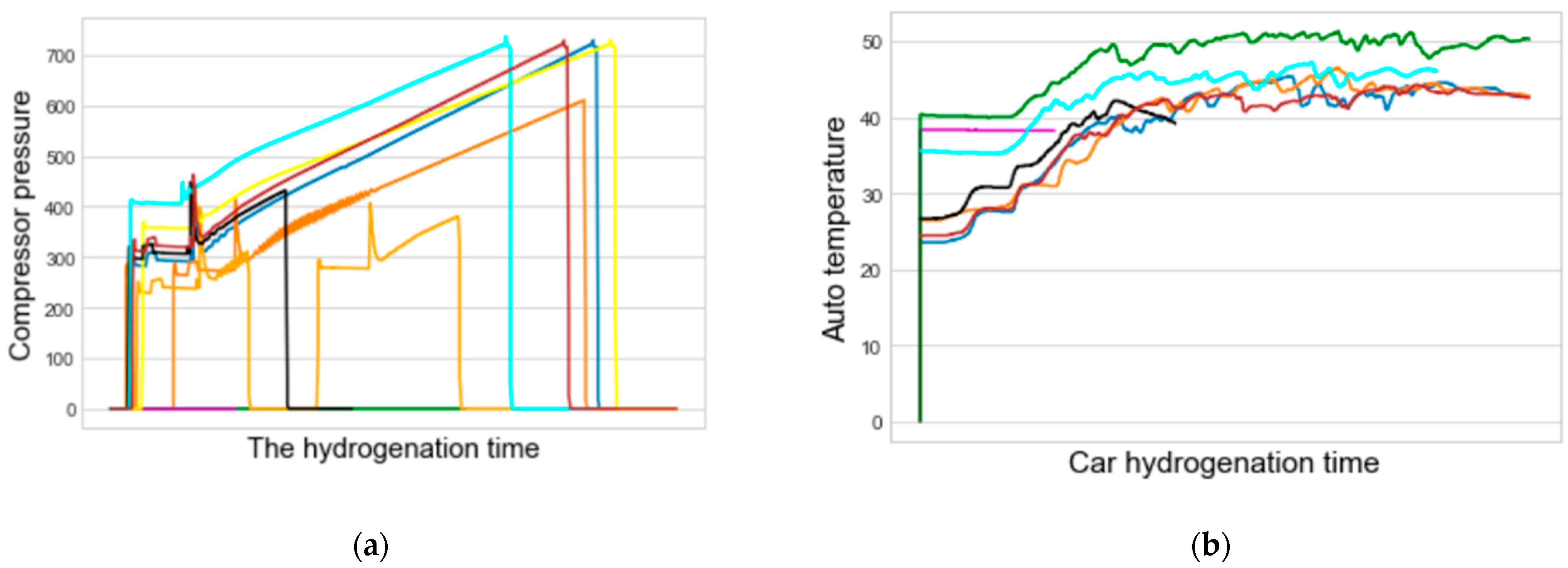
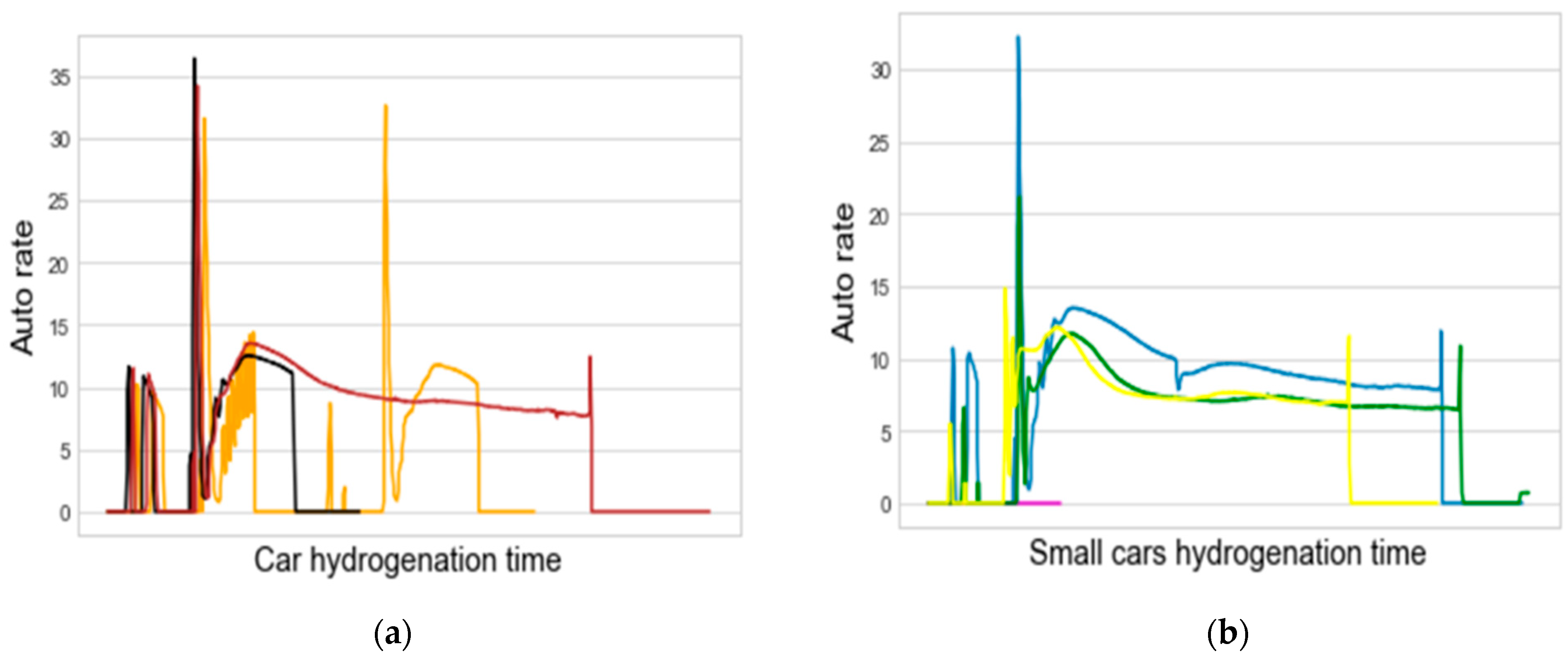
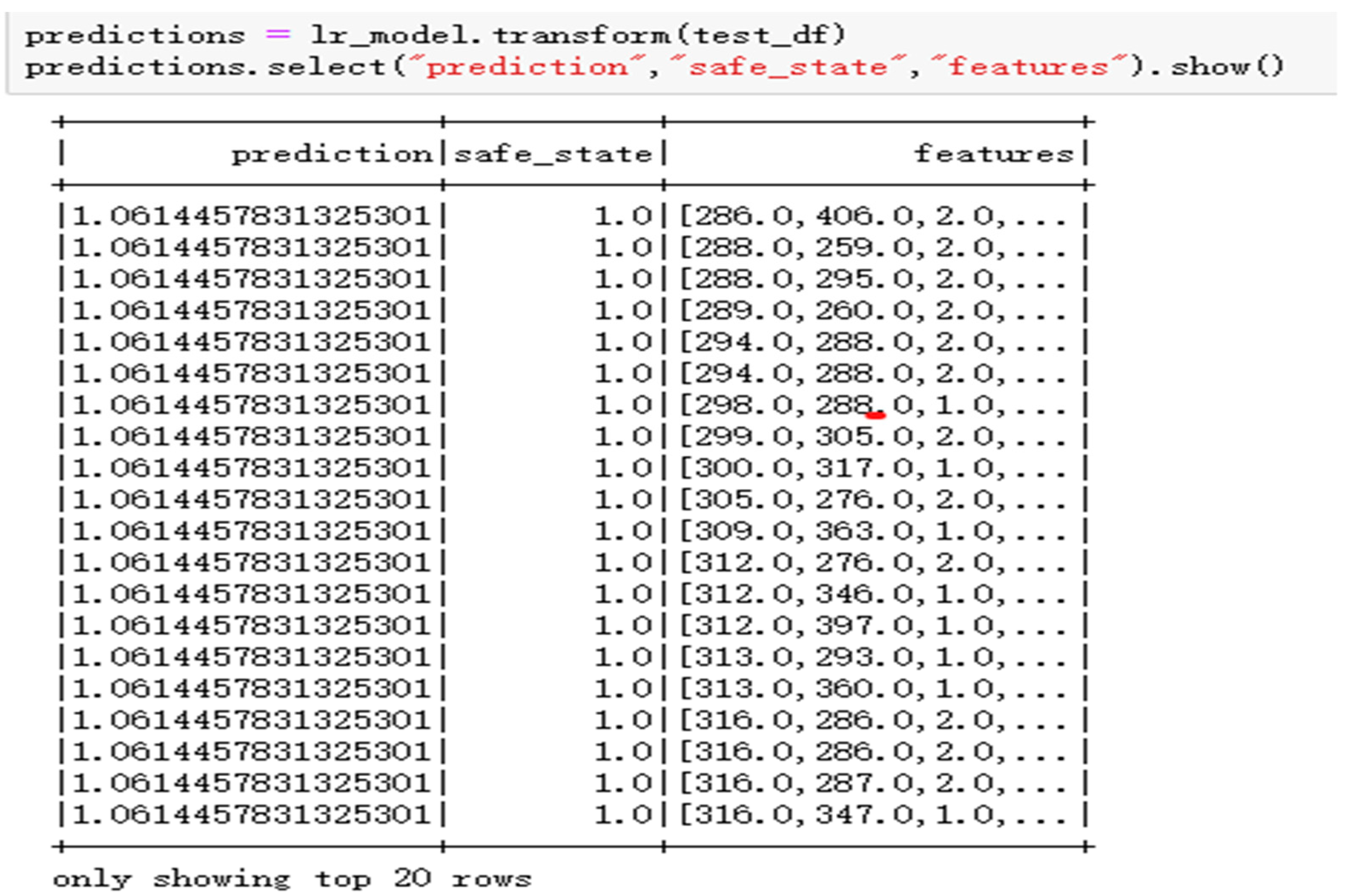
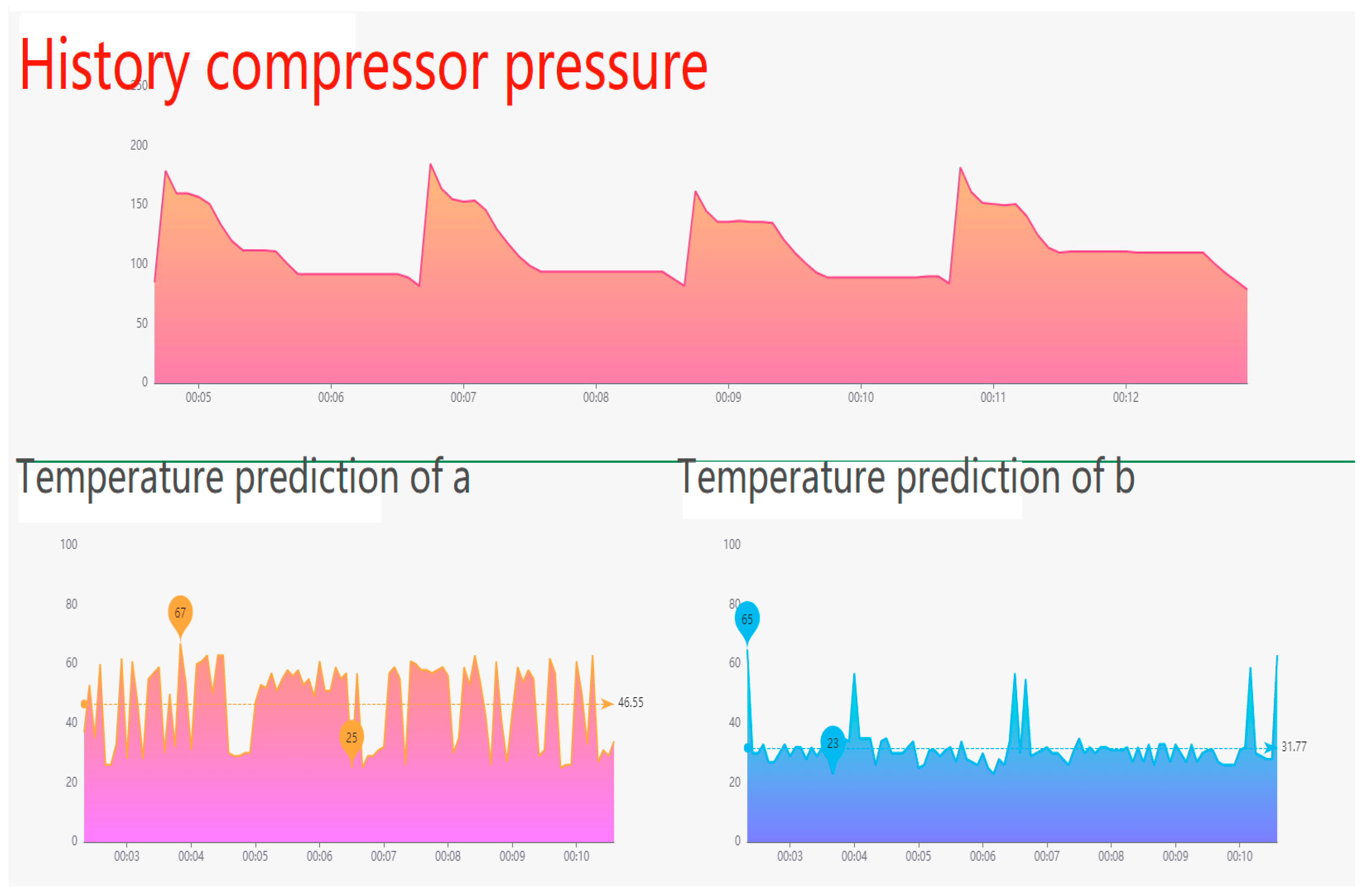
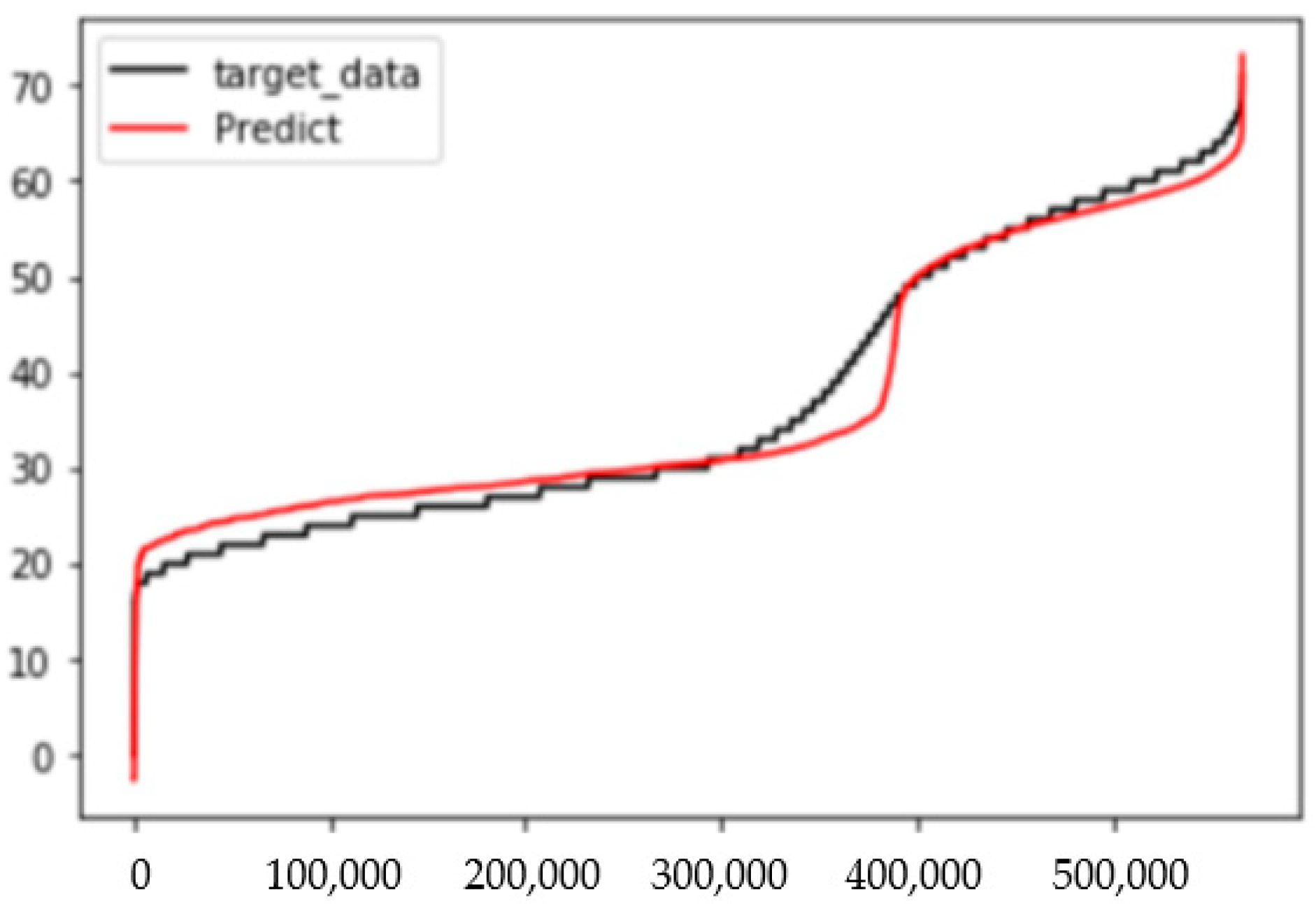
| Name | Stddev | Max |
|---|---|---|
| Pressure_in_a | 65.337 | 350.0 |
| Pressure_out_a | 160.751 | 420.0 |
| Temp_out_a | 15.320 | 68.0 |
| Pressure_in_b | 30.446 | 192.0 |
| Temp_out_b | 10.078 | 67.0 |
| High_pressure_out | 32.632 | 412.0 |
| Mid_pressure_out | 41.676 | 414.0 |
| Safe_state | 0.219 | 2.0 |
| Hydrogenation time | 2.449 | 9 |
Publisher’s Note: MDPI stays neutral with regard to jurisdictional claims in published maps and institutional affiliations. |
© 2021 by the authors. Licensee MDPI, Basel, Switzerland. This article is an open access article distributed under the terms and conditions of the Creative Commons Attribution (CC BY) license (https://creativecommons.org/licenses/by/4.0/).
Share and Cite
Yang, W.; Dong, J.; Ren, Y. Hydrogen Safety Prediction and Analysis of Hydrogen Refueling Station Leakage Accidents and Process Using Multi-Relevance Machine Learning. World Electr. Veh. J. 2021, 12, 185. https://doi.org/10.3390/wevj12040185
Yang W, Dong J, Ren Y. Hydrogen Safety Prediction and Analysis of Hydrogen Refueling Station Leakage Accidents and Process Using Multi-Relevance Machine Learning. World Electric Vehicle Journal. 2021; 12(4):185. https://doi.org/10.3390/wevj12040185
Chicago/Turabian StyleYang, Wujian, Jianghao Dong, and Yuke Ren. 2021. "Hydrogen Safety Prediction and Analysis of Hydrogen Refueling Station Leakage Accidents and Process Using Multi-Relevance Machine Learning" World Electric Vehicle Journal 12, no. 4: 185. https://doi.org/10.3390/wevj12040185
APA StyleYang, W., Dong, J., & Ren, Y. (2021). Hydrogen Safety Prediction and Analysis of Hydrogen Refueling Station Leakage Accidents and Process Using Multi-Relevance Machine Learning. World Electric Vehicle Journal, 12(4), 185. https://doi.org/10.3390/wevj12040185






